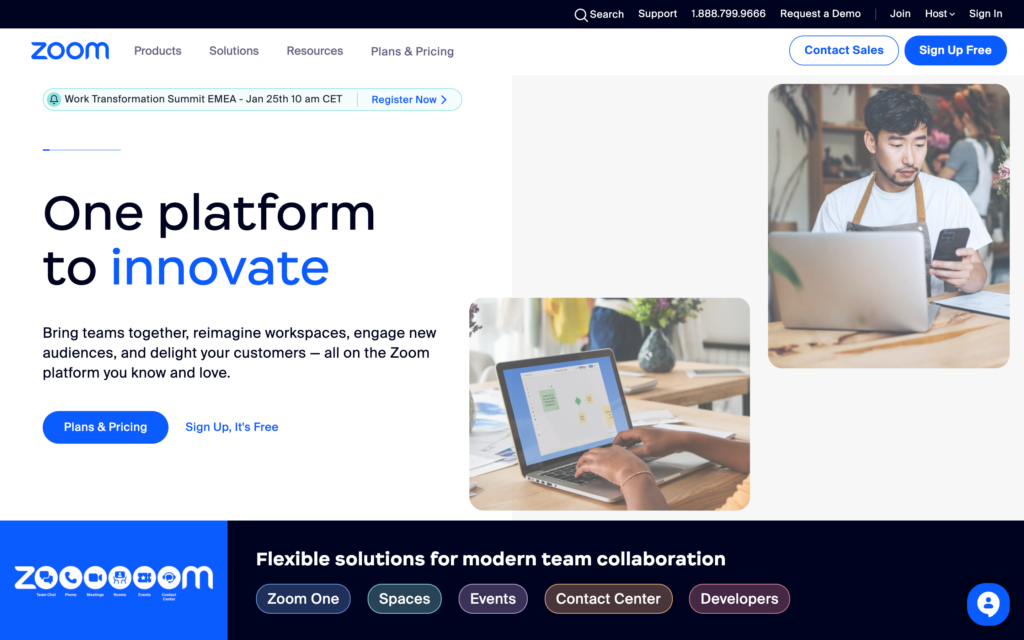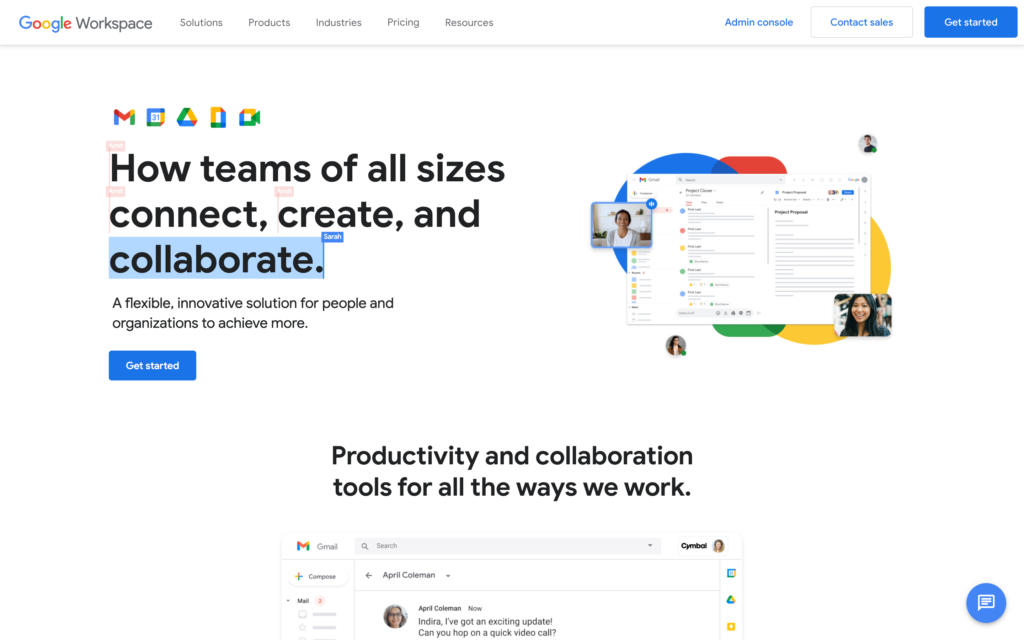Digital communication tools are essential for engaging with your team throughout the workday and maximizing productivity. We explain the benefits of digital communications and highlight our 3 favorite platforms to use.
Digital communication tools play an essential role in everyday business operations. They allow you to maintain contact with your team throughout the workday so you can answer questions, get updates on work, and more. They also facilitate communication by enabling your employees to talk with one another without them having to be in the same room.
In this guide, we explain the benefits of using software to communicate in the workplace and highlight 3 of our favorite tools to keep your team in the loop.
Key Takeaways
- Digital communication is any form of electronic communication. It includes email, text messaging, instant messaging, video conferencing, social media, and more.
- Using digital communication tools in the workplace can increase productivity, enhance collaboration, and improve your customer experience.
- These tools also make it easier to organize and retain information.
- Three of the best digital communication tools to use today are Connecteam, Zoom, and Google Workspace.
What Is Digital Communication?
Digital communication includes any form of communication that takes place digitally, primarily on a computer, smartphone, or other mobile device such as a tablet. It includes everything from emails and text messages to video calls and social media interactions.
Your business probably already uses some forms of digital communications. It’s rare to find a business today that operates without email, for example. And, in the era of remote work, video conferencing and instant messaging platforms are increasingly common.
One of the key characteristics of digital communication is that information is transmitted instantaneously. As soon as you send a message, it’s delivered to your team and they can get on with their work.
In productivity terms, this is a huge step up from leaving a handwritten note on each employee’s desk or having to track down your employees in the office to share information.

What Are the Benefits of Communication in the Digital Age Workplace?
The benefits of digital communication in the workplace are so numerous that almost no business today still runs entirely on analog communication. Let’s take a closer look at some of the key benefits that digital tools provide.
Instant information sharing
The number-one benefit of digital communication tools is that they enable you to share information instantly. You can have a back-and-forth with an employee by text message in real time. You can also jump on a video call to discuss more complex ideas.
Both of these methods get information across much faster than if you had to walk to an employee’s office to chat with them face-to-face or leave them a note. You can simply exchange information and then get back to work quickly.
Did You Know?
Connecteam’s Updates feature lets you send visually-appealing and engaging updates to your entire workforce with just the tap of your finger.
✔️ Add GIF, images, videos and more to make your updates stand out
✔️ Allow/disallow comments and likes
✔️ Use your logo and branding colors to build trust and recognition
Get started with Connecteam for free today!
Increased productivity
The speed of digital communications has a big impact on productivity. Employees can get the information they need as soon as they need it—no more time wasted waiting for in-person meetings.
Since information is transmitted efficiently, there’s less downtime during the workday. This has huge benefits for your company, as more productive employees can help get more work done on a faster timescale. This brings in more revenue, helps you stick to deadlines, and boost customer satisfaction.
Greater flexibility
With digital communications, you and your employees don’t need to be in the same place in order to share information effectively. You can be in the office texting with employees in the field, for example. Digital communication tools also support employees who work remotely or from home.
In addition, with digital communication tools, employees don’t necessarily need to work at the same time. Asynchronous communication platforms let you send a message, voice note, or video to employees, who then can respond later when they have time.
Improved information retention
Another benefit of digital communication tools is that they make it easy to save information. Where a paper note might get lost in the shuffle, a digital message lasts forever.
You can organize emails and other digital communications into folders and search through them later. This ensures that information is preserved within your business for anyone who might need it later. It also simplifies compliance with labor regulations that require you to save certain documents or communication records.
Better customer experience
In addition to helping your employees, digital communication helps your customers.
Digital platforms enable customers to reach your business more easily with questions. They can get instant responses from a chatbot or send questions to your team through email.
You can also work collaboratively with customers through digital communication platforms like messaging apps. For example, you can have a shared messaging channel that includes your team and representatives from your customer’s business. This gives customers a greater voice in the work your business does for them.
Did You Know?
With Connecteam’s Chat, you can create smart groups that automatically add employees based on pre-defined feature such as their location, position, shift, teams, and many more. This gives you a dedicated communication channel for anything that is relevant only to these employees.
Streamlined collaboration
Digital communication enhances collaboration within your team in several important ways.
First, it enables employees to work together in real time without being in the same room. Employees can share information about a project through messages or group emails, or brainstorm or solve problems through video conferences.
Additionally, digital tools enable employees to work asynchronously. Instead of requiring all employees to set aside time for a meeting, they can work on a collaborative project whenever it best fits their schedule.
Digital communication platforms also offer ways to organize communication around different tasks and projects. This makes it easier for employees who may be working on multiple projects together to keep track of important information.
Face-to-Face Communication vs. Digital Communication
Although there are many benefits to digital communication in the workplace, digital exchanges still can’t fully replace face-to-face communication. According to one study, in-person communications have a different and stronger effect on neurological connections in the brain compared to virtual exchanges. That is, in-person communication is more effective for brainstorming than virtual communication.
However, not every exchange of information needs to be in-person. In fact, it’s often much more efficient to hold most communications digitally while maintaining some degree of face-to-face interactions. For example, you might reserve in-person meetings for making big decisions as a team.
As technology advances, the line between digital and face-to-face communications is blurring. Video conferencing has come a long way in the past several years. In addition, new virtual reality technology could make remote meetings feel just like in-person meetings in the near future.
Examples of Digital Communication Channels in the Workplace
Text channels
Text channels are the type of digital communications that most people are familiar with. They include text messages, emails, and messages sent within business chat apps.
Your company’s intranet can also serve as a channel for text communications. For example, a digitized employee handbook posted to your intranet is a form of digital communication.
Audio notes
Audio notes are becoming increasingly popular as a way to communicate information quickly. Many platforms that support text messages, such as smartphone SMS apps and business chat apps, now support audio notes as well.
Video conferencing
Video conferencing tools offer a variety of capabilities. You can hold a 2-way video call or a larger meeting. You can also host a webinar or record a video and share it via email or a chat app.
Social media
You may be most used to social media in your personal life, but it can be a very useful channel for connecting with customers. You can also use a social media-style feed within your business to share major announcements.
Surveys
Surveys are an effective digital tool for collecting feedback or ideas from your employees. With a platform like Connecteam, you can decide whether surveys should be anonymous or have employees’ names attached.

Project management tools
Many project management tools include features that help your team communicate about work in progress. For example, you can attach documents and notes to a task and assign it to an employee, who will receive a notification that they have a new assignment.
Calendars
Calendars offer a way to communicate about meetings, deadlines, and other events. For example, you can send a calendar invite to employees about an upcoming video conference.
Workplace Digital Communication Guidelines
To help you get the most out of digital communications within your workplace, here are a few guidelines to follow.
Use multiple channels to communicate
Using multiple channels to communicate with your team gives you more flexibility and enables you to share information more effectively. For example, you might use text messaging for a simple back-and-forth with one employee, but opt for a video conference for brainstorming or decision-making as a team.
As a rule of thumb, focus on using 2 to 4 communication channels that work best for your team.
Dedicate time to training
Depending on the digital communication tools you use, they can take a bit of time to get used to. Thus, it’s important that you spend time training employees on how to use them properly. Training can include explaining not only how a software works but also how you expect your team members to use it throughout the day.
Pro Tip
The best workplace digital communication tools will have little to no learning curve so even your least tech-savvy employees can get started with it in minutes—and continue using it without any hassle.
Don’t overload employees with notifications
Some tools make communication so seamless that it’s easy to overload employees with notifications. One way to avoid this is to target your messages to the specific employees that need a piece of information. If a topic requires a lot of back-and-forth messaging, it might be easier to jump on a quick voice or video call.
Organize your messages
Many business chat apps let you organize your conversations into channels. You can create a new channel for each project or team you and your employees work on. This not only makes it easier to find information later but also ensures that your messages go only to the employees to whom the information is relevant.
Develop a company-wide communication policy
Every business should have a clear communication policy, and yours should be included in your employee handbook.
Your communication policy can lay out what communication tools you use and when to use them. It can also establish guidelines for what types of speech are allowed and what topics are off-limits in your business communications. This is important for ensuring your workplace feels inclusive for all employees.
Best Digital Communication Tools and Software for 2025
There are dozens of platforms for digital communication in the workplace, and we’ve narrowed them down to our top 3 picks.

Connecteam is an all-in-one work operations platform that includes tons of features for communicating with your team.
To start, Connecteam offers an easy-to-use chat feature that’s built right into the app. You can send messages, voice notes, photos and videos, attachments, and more. It supports both one-on-one and group conversations, and you can organize your chats into task or team-based channels.
One thing that separates Connecteam from other chat apps is the level of control it affords managers. You get to decide which employees can join and post in which channels, and you can moderate conversations to ensure they stay on-topic and professional.
For department or company-wide announcements, Connecteam offers a social media-style updates feed. It supports comments and likes, although you also have the option to turn these off for any post. You can schedule posts ahead of time and keep track of who has viewed your updates, too.
Connecteam also streamlines the process of collecting feedback from employees with customizable surveys and polls. Surveys support anonymous responses, and you can even hold live polls to collect feedback instantly.
Other communication features in Connecteam include an employee directory, knowledge center, and events calendar. The knowledge center enables you to store important documents like your employee handbook, operations documents, and more.
Plus, Connecteam includes project management tools that enable employees to share notes on ongoing tasks.
Connecteam is completely free to use for businesses with up to 10 employees. For larger businesses, pricing starts at just $29 per month for up to 30 users.
Get started with Connecteam for free today!

Zoom is a widely used video conferencing solution that can help remote teams collaborate. Managers can hold one-on-one meetings or host up to 1,000 attendees at a time. Users can host live polls during meetings or share screens for presentations.
Zoom meetings include virtual whiteboards, which enable users to share ideas and make decisions together. Whiteboards support concurrent editing and can be customized with templates to help jumpstart the ideation process.
The software also lets hosts split attendees into breakout rooms during a meeting. This enables employees to work on ideas in small teams and then report back to the entire group.
Additionally, Zoom includes an email client, shared calendar, and a team chat.
Zoom offers a free plan that limits users to 40-minute meetings. Paid plans start at $15.99 per user, per month.

Google Workspace is a productivity suite that includes apps like Google Drive, Gmail, Meet, and more. Drive is especially interesting as a communication tool because of how it facilitates collaboration within teams.
With Google Drive, multiple employees can edit the same document, spreadsheet, or presentation at the same time. They’re also able to leave comments within a document.
Commenting enables employees to work asynchronously, which is helpful for teams spread across multiple time zones. Comments are threaded so that employees can have back-and-forth conversations.
In addition, since Google Drive is part of Google Workspace, employees can launch video calls with Meet when they need to discuss a task in greater detail.
Google Drive also allows users to organize files into folders and share them with groups of employees. Managers can leave a note when sharing files as well as control who has permission to edit a file’s contents.
Google Workspace starts at $6 per user, per month.
Conclusion
Digital communications include messaging, social media, video conferencing, and much more. Within the workplace, digital communication tools can make it easier for employees to collaborate, as well as help improve productivity and assist you in organizing information.
There are countless options out there, but three of our favorite favorite digital communication tools for businesses are Connecteam, Zoom, and Google Workspace. Comparing the 3 platforms, Connecteam stands out as the best all-in-one solution. It offers a free plan for businesses with 10 or fewer employees, plus affordable paid plans for teams of all sizes.
FAQs
What is the definition of digital communication?
Digital communication is any type of communication that takes place electronically, typically over the internet. It includes email, instant messaging, video calling, and social media.
What is the most common type of digital communication in the workplace?
Common types of digital communication in the workplace include email, instant messaging, and video conferencing. Very few businesses could operate without email, and a growing number rely on instant messaging within teams to share information quickly. Meanwhile, video conferences enable teams to meet virtually.
Why is digital communication important for businesses?
There are a number of benefits of digital communication in the workplace. First and foremost, digital communication tools enable businesses to share information quickly. They’re essential for also communicating with customers, facilitating collaboration between employees, and increasing productivity. Almost all businesses today rely on digital communications.




